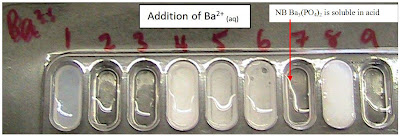The key is;
1) OH-(aq)
2) NO3-(aq)
3) Cl-(aq)
4) CO32- (aq)
5) SO42- (aq)
6) PO43- (aq) in neutral conditions
7) PO43- (aq) in acidic conditions
8) PO43- (aq) in basic conditions
9) I- (aq)
PHOTO RESULTS
TABLE OF RESULTS
The full table of results can be downloaded at the link here. The file has two tabs, the first showing the correct results. The second tab showing our creativity and 'interesting' results. If nothing else these results demonstrate that old saying 'One person's sunshine is another persons sewerage'
AND - Here is another preview of Kingdom Rush 2 - not long now!
FEEDBACK
Worksheets
Generally well done. Tips:Worksheets
b) When explaining flame tests it is important to say that when the atom absorb (heat) energy from the flame the electrons jump to higher orbitals, but when (they cool &) the electrons jump back to lower orbitals they emit light with specific energy (and thus colour) corresponding to the energy DIFFERENCE between the orbitals. These energy jumps, and thus colours, are unique to each element.
d) & e) ppm and unit conversions. A number of silly mistakes and errors here. REMEMBER that 1L = 1000g. Unit conversion is a skill that takes a fair bit of practise to master but once you get it – you have it forever.
i) be careful to answer the question. The studetn didn't know what the ions were so would have had to go through the whole cation test process - you just needed to indicate whatthye would observe along the way.
k) & l) You need to revive excess and limiting reagent precipitation questions - particularly when asked to calculate concentrations of ions remaining in solution - you need to understand that any ion that ends up in the precipitate is no longer 'in solution'.
m) Ionic equations only include reacting ions (no spectator ions) and MUST include states. You have to be very careful to use our solubility tules when determining which ions form the precipitate.
n) & q) When explaining which ion must/must be in solution you have to give reasons. Questions n (a) and q needed some extra care in this regard. E.g. for n(a) it was insufficient to say it contained lead because it produces precipitates with sulfate, chloride and hydroxide ions. You needed to also why it COULDN’T be calcium – ie because it does NOT form a precipitate with chloride ions.
r) Again - remember that 1 mL = 1g, 1 L = 1000 g
BTW – Question n (c) and Question (o) had mistakes. Apologies.
n (c) should have said “…AND a precipitate with AgNO3.”
(o) should have had the last two columns identical with ppt for both hydroxide and sulfate but not chloride.
Summary
Generally VERY good
A) Safety – need to specify which are the heavy metals, their dangers, precaution and disposal strategies. Ditto for the acidic and basic chemicals. Finally you needed to specify why there was no flame test for lead. Don’t worry about the other chemicals.
B) Flow charts – States are need for all reactions. Take care with your charges on ions. Equations must be balanced.
C) Relevant Chemistry – make sure you are thorough in your explanation of the logic behind the choice of steps – focus on the broad reasons for choosing the steps for any sequence of precipitation testing – bit just the steps we used in our flowchart BUT you should include a specific example from our flowchart to illustrate the consequences of not testing in the correct order. eg when testing for cations if we had added sulfate first…
D) Some people were missing part of the table – please ensure the table is complete.
E) Sulfate precipitates with barium ions in acidic conditions but phosphate and carbonate wont (because carbonates react to form carbon dioxide in acidic conditions and phosphates are soluble in acidic conditions) BUT ALL THREE will precipitate with barium ions in neutral and basic conditions
F) Compare is a fairly low level verb – just similarities and differences – ie “Both are about the dangers of lead but…” then just a sentence comparing the differences of each issue style, purpose, accuracy, reliability. – 5 lines max? (but don’t forget the similarity – they are both about…)
G) This is a 1 page summary and 1 page flowchart report
H) Nitrates do NOT form precipitates. When you look at the formula for nitrate I want you to see NO3, ie NO precipitates
While marking this summary I was watching 'Giggle & Hoot' on ABC2 with my kids. This song really grabbed me. Probably the best song I have heard all year. On par with 'Life's a Happy Song' and 'Feel Inside - & Stuff Like That'.















No comments:
Post a Comment